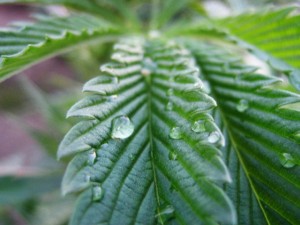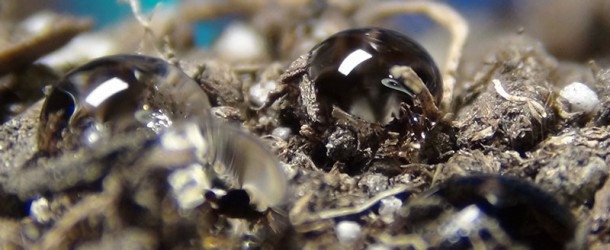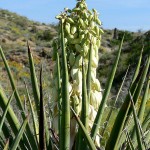Have you ever let a potted plant become so dry that the water just beads up and rolls off? Â When this happens, it is because the dry soil has become hydrophobic. It is repelling the water. Â In this situation, you need to use a surfactant. Â The surfactant works as a double agent, bringing both the hydrophobic soil and the hydrophilic water to a point where they can merge.
 Surfactants, or wetting agents, help reduce surface tension. These unique compounds are amphiphilic, containing both water soluble and water insoluble components. Some surfactants are also lipophilic, and can serve as emulsifiers, enabling water soluble compounds to mix with oil soluble compounds. The most common household surfactant is detergent.Â
Surfactants, or wetting agents, help reduce surface tension. These unique compounds are amphiphilic, containing both water soluble and water insoluble components. Some surfactants are also lipophilic, and can serve as emulsifiers, enabling water soluble compounds to mix with oil soluble compounds. The most common household surfactant is detergent.Â
Surfactants are also useful in foliar sprays. Â By reducing surface tension, spray solutions can coat surfaces more easily without beading. Â When using an oil soluble spray, ad an emulsifying surfactant for mixing with water. This is the procedure for spraying dormant oil on fruit trees. I do not know of any marijuana specific sprays that require an emulsifying surfactant.
I use surfactants almost every time I water marijuana plants, both indoor and out. Â I always try to imagine the planting mix on a microscopic level–an assemblage of cocoa fiber, perlite, and guano coming together and creating tiny pockets of both air and water. Â I imagine the surfactants working to help deliver my fertilizer solution to the roots. Â I also use wetting agents for better coverage every time I spray a foliar product. Â Many commercially available foliar sprays already include surfactants; but I still add a little more.
Let’s take a look at a few of the surfactants currently on the market.
ThermX 70
Derived form Yucca schidigera, a small desert tree, this stuff is very concentrated. One bottle will last years if stored properly. Â I apply at a rate of 2 tsp/50 gallons. It will foam if agitated; but I have never had this trouble. Â ThermX 70 is approved for organic crop production, and has been awarded an OMRI listing.
Earth Juice Assist
Made from the Yucca tree, Â EJ Assist is derived from ThermX 70. Â Assist also contains humates to aid in fertilizer delivery. Â Earth Juice Assist is much more affordable than ThermX 70. Being less concentrated, Assist is probably a more practical product for the casual gardener.
Dutch Master – Penetrator
I have only used one bottle of Penetrator. A grow shop owner gave it to me on a trial basis. Â The packaging does not identify the contents, and neither can I. Â As I recall, it was a light green, possibly clear liquid with a viscosity comparable to water. Â It had no discernible odor. Â When I used it, my foilar sprays had nice even adhesion; and the bottle lasted me quite a while.
Household detergents
Dish washing detergents are perfectly suitable for use as wetting agents. Â Avoid antibacterial detergents, and those containing perfumes or dyes. Â The most common active ingredient, sodium lauryl sulfate, sounds like a nasty chemical; but before you write it off, check your shampoo bottle. Â Sodium lauryl sulfate is a very common household surfactant, found in almost all shampoos. Â My favorite detergent is Dawn original–not the concentrated or scented versions. Â I mix at the rate of one drop per gallon, or two teaspoons per 50 gallons. Honestly, Dawn is the wetting agent I use most often.
Surfactants: Is Your Water Wet Enough?,










I am interested if anyone else has used detergent to help their plant grow better.
From what I understand about what this does, the process should also help the plant absorb more liquid, correct?
Visuallizing your surfacants delivering nutrients to your roots of course does nothing. Typical potting soils have a significant amount of components that do not readily combine with water. Sand, perlite, can get wet but do not absorb water. The problem of soil wetting can be overcome simply by buying a watering wand that has very fine holes that deliver water in a gentle stream. These are used by commercial greenhouses to water seed flats. With the right tools you can avoid adding chemicals. Wetting agents and surfacants are used in commercial agricultural spraying, not to deliver nutrients or to foliar feed the plant/tree, but to create more even delivery of pesticides, basically, so that all spots are covered and water does not rinse off the pesticide. Leaves do not take in nutrients or water all over the leaf. The same surfacants that you add also prevent effective delivery to the watering hole of the leaf.
@ onjray
I wouldn’t expect use of surfactants to directly facilitate solution absorption, but it can help deliver water to areas where the water is needed. It possible that reduction of surface tension can even work as a detriment to capillary absorption. Really, in a soil application the surfactants are simply intended to assist in solution/water penetration.
@ the Doctor Speaks
Very good point, oxygenating watering wands are great for delivering water where it’s needed. Watering wands offer some remedy for wetting hydrophobic potting mixes, surfactants offer another. I do need to challenge your statement;
“The same surfacants that you add also prevent effective delivery to the watering hole of the leaf”
I am very interested to explore any reference material you may have on this subject. If this is the case I will be happy to update this article, offering elaboration on this idea.
.
Theoretically cant you avoid all this if you have a watering regime to keep soil moist? Spraying the plant with a water mister throughout the day would help also wouldn’t it?
Misting foliage in early morning hours is most closely emulating a natural condition. Water droplets on foliage in full sunlight, is not typically occurring in nature. Droplets can act as a wee magnifying glass.
One looks forward to learning more of the surfactant clogged : “watering hole of the leaf†.
I have no experience or data either way on that.
I am not completly sure because this is my first plant…i think its an afghani indica….anyway when i switched it to flower mode or 12/12 the new leaves started turning purple and there glowing with thc crystals…but i just switched it like less than a week ago.Is this normal? I dont want it to just shoot up out of nowere i have limited grow space.